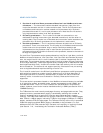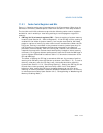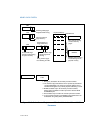
11-14 Vol. 3
MEMORY CACHE CONTROL
The L1 instruction cache in P6 family processors implements only the “SI” part of the
MESI protocol, because the instruction cache is not writable. The instruction cache
monitors changes in the data cache to maintain consistency between the caches
when instructions are modified. See
Section 11.6, “Self-Modifying Code,” for more
information on the implications of caching instructions.
11.5 CACHE CONTROL
The Intel 64 and IA-32 architectures provide a variety of mechanisms for controlling
the caching of data and instructions and for controlling the ordering of reads and
writes between the processor, the caches, and memory. These mechanisms can be
divided into two groups:
• Cache control registers and bits — The Intel 64 and IA-32 architectures
define several dedicated registers and various bits within control registers and
page- and directory-table entries that control the caching system memory
locations in the L1, L2, and L3 caches. These mechanisms control the caching of
virtual memory pages and of regions of physical memory.
• Cache control and memory ordering instructions — The Intel 64 and IA-32
architectures provide several instructions that control the caching of data, the
ordering of memory reads and writes, and the prefetching of data. These instruc
-
tions allow software to control the caching of specific data structures, to control
memory coherency for specific locations in memory, and to force strong memory
ordering at specific locations in a program.
The following sections describe these two groups of cache control mechanisms.
Table 11-4. MESI Cache Line States
Cache Line State M (Modified) E (Exclusive) S (Shared) I (Invalid)
This cache line is valid? Yes Yes Yes No
The memory copy is… Out of date Valid Valid —
Copies exist in caches
of other processors?
No No Maybe Maybe
A write to this line … Does not go to
the system bus.
Does not go to
the system bus.
Causes the
processor to gain
exclusive
ownership of the
line.
Goes directly to
the system bus.


















